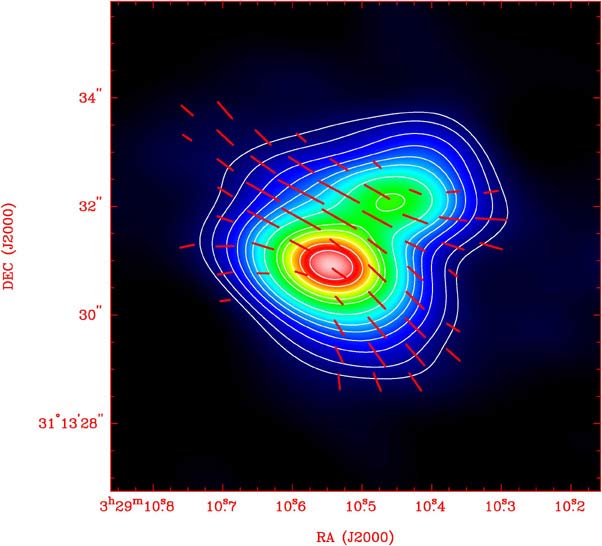Star Warp: Long-Sought Shapely Space Figure Found

For a star to form, gravity has to overcome buoyant magnetic forces that fight to keep a cloud of gasand dust from collapsing. Theorists have long suspected that the competitionbetween gravity pulling inward and magnetic pressure pushing outward wouldproduce a warped, hourglass pattern to the magnetic field within thesecollapsed cores.
Now they've finally found just such a shape.
Observations by the Smithsonian's Submillimeter Array (SMA)has found the first conclusive evidence of an hourglass-shaped magnetic fieldin a starformation region.Measurements indicate that material in the interstellar cloud is dense enoughto allow it to gravitationally collapse, warping the magnetic field in theprocess.
The cloud, called NGC 1333 IRAS 4A, is actually forming twostars. It is relatively nearby at 980 light-years away in the direction of theconstellation Perseus. The setup is part of the Perseusmolecular cloud complex, a vast collection of gas and dust holding as muchmass as 130,000 suns where stars are actively forming.
"We selected this system because previous work had offeredtantalizing hints of an hourglass-shaped magnetic field," said Dan Marrone(Harvard-Smithsonian Center for Astrophysics. "The Submillimeter Arrayoffered the resolution and sensitivity we needed to confirm it."
The researchers observed dust emission from the cloud.Because the magnetic field aligns the dust grains in the cloud core, the teamwas able to measure the magnetic field's geometry and estimate its strength bymeasuring the polarization of the dust emission.
"Withthe special polarization capabilities of the SMA we see the shape of the fielddirectly," said Ramprasad Rao (Institute of Astronomy and Astrophysics,Academia Sinica. "This is the first textbook example of theoreticallypredicted magnetic structure."
Get the Space.com Newsletter
Breaking space news, the latest updates on rocket launches, skywatching events and more!
The results were detailed last week in the journal Science.
This article is part of SPACE.com's weekly Mystery Mondayseries.
Top 10 Star Mysteries
Stars, Galaxies, and Universe Wallpaper
Mystery of Magnetic Stars Solved
The Strangest Things in Space
Join our Space Forums to keep talking space on the latest missions, night sky and more! And if you have a news tip, correction or comment, let us know at: community@space.com.

Space.com is the premier source of space exploration, innovation and astronomy news, chronicling (and celebrating) humanity's ongoing expansion across the final frontier. Originally founded in 1999, Space.com is, and always has been, the passion of writers and editors who are space fans and also trained journalists. Our current news team consists of Editor-in-Chief Tariq Malik; Editor Hanneke Weitering, Senior Space Writer Mike Wall; Senior Writer Meghan Bartels; Senior Writer Chelsea Gohd, Senior Writer Tereza Pultarova and Staff Writer Alexander Cox, focusing on e-commerce. Senior Producer Steve Spaleta oversees our space videos, with Diana Whitcroft as our Social Media Editor.











